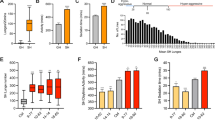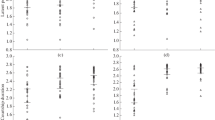Abstract
Effects of β-alanine on mating behavior and aggression were studied inDrosophila melanogaster using the following competitive pairs: (1) homozygous black (b/b) flies, in which β-alanine synthesis is decreased, vs. alanine is blocked vs. wild-type (e +/e+) flies; (2) dark flies, in which β-alanine incorporation is reduced, owing mainly to chromosome 3, vs. light flies collected from the same population as were the dark flies; (3) homozygous black (b/b) flies, in which β-alanine synthesis is decreased, vs. β-alanine-injectedb/b flies, which are phenocopies of wild-type flies. The behavior of mixed-sex groups was studied in a large, illumination-graded observation chamber containing food and in small uniformly illuminated cells also containing food. The relative competitive mating abilities of these types were measured in both experimental conditions. Uninjected black flies, but not injected ones, showed weak and unsteady gait and weak wing extension. In ebony these abnormalities were more extreme. Dark flies did not show these abnormalities. Accelerated sexual maturation was indicated in males by early onset of courtship and enhanced territorial aggression and in females by earliness of mating. Such acceleration was observed in ebony and dark flies, compared with light flies, and among β-alanine-injectedb/b flies competing with uninjected black flies. Ebony males, although maturing earlier than wild-type males, were less successful than wild-type males in mating. This difference was even greater when the flies were all allowed to mature before competing. Ebony females outmated wild-type females. Dark flies outmated light flies, and β-alanine-injectedb/b males outmated uninjected black males, especially in bright light. Ebony flies mated much longer than wild-type flies, and black flies mated slightly longer than injectedb/b flies. There was some spatial isolation of ebony from wild type, dark from light, and β-alanine-injected from uninjectedb/b flies in the illumination-graded observation chamber. Ebony flies more than wild type concentrated near food. Flies were attracted to the current of moist inlet air. They were also attracted to deposited excrement, and males defended such deposits as a mating area, thus showing rudiments of arena behavior in which a mating area away from the oviposition site is defended. Usually, however, the defended area focused on food.
Similar content being viewed by others
References
Averhoff, W. W., and Richardson, R. H. (1976). Multiple phermone system controlling mating inDrosophila melanogaster Proc. Natl. Acad. Sci.,73:591–593.
Dow, M. A., and von Schilcher, F. (1975). Aggression and mating success inDrosophila melanogaster.Nature 254:511–512.
Elens, A. A. (1957). Importance selective des differences d'activite entre males ebony et sauvage, dans les populations artificialles deDrosophila melanogaster.Experientia 13:293–297.
Jacobs, M. E. (1955). Studies on territorialism and sexual selection in dragonflies.Ecology 36:566–586.
Jacobs, M. E. (1960). Influence of light on mating ofDrosophila melanogaster, Ecology 41:182–188.
Jacobs, M. E. (1961). The influence of light on gene frequency changes in laboratory populations of ebony and non-ebonyDrosophila melanogaster.Genetics 46:1089–1095.
Jacobs, M. E. (1966). Deposition of labeled beta-alanine in ebony and non-ebonyDrosophila melanogaster with notes on other amino acids.Genetics 53:777–784.
Jacobs, M. E. (1968). β-alanine use by ebony and normalDrosophila melanogaster with notes on glucose, uracil, DOPA, and DOPAmine.Biochem. Genet. 1:267–275.
Jacobs, M. E. (1974). Beta-alanine and adaptation inDrosophila.J. Insect Physiol. 20: 859–866.
Jacobs, M. E. (1976). Binding of beta-alanine, DOPAmine, and DOPA 1-C-14 by normal, ebony, and darkDrosophila melanogaster cuticles.Insect Biochem. 6:497–499.
Jacobs, M. E. (1978). Beta-alanine tanning ofDrosophila cuticles and chitin.Insect Biochem. 8:37–41.
L'Heritier, P., Neefs, Y., and Teissier, G. (1937). Apterisme des insects et selection naturelle.Compt. Rend. (Paris) 204:907–909.
Morgan, T. H., and Bridges, C. B. (1919). The inheritance of a fluctuating character.J. Gen. Physiol. 1:639–643.
Noble, G. K. (1939). Symposium on the individual vs. the species. IV. The role of dominance in the social life of birds.Auk 56:263–273.
Scheffé, H. (1958).The Analysis of Variance, Wiley, New York.
Spieth, H. T. (1968). Evolutionary implications of sexual behavior inDrosophila.Evol. Biol. 2:157–193.
Author information
Authors and Affiliations
Additional information
This work was supported by Grant GM-18680 from the National Institutes of Health.
Rights and permissions
About this article
Cite this article
Jacobs, M.E. Influence ofβ-alanine on mating and territorialism inDrosophila melanogaster . Behav Genet 8, 487–502 (1978). https://doi.org/10.1007/BF01067478
Received:
Accepted:
Issue Date:
DOI: https://doi.org/10.1007/BF01067478




